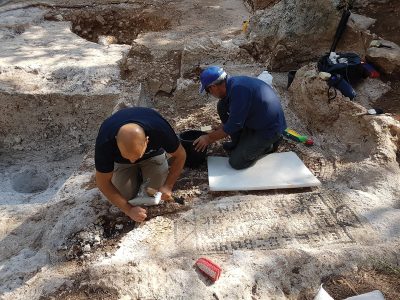×


We have detected your country as:
Please click here to go to the USA website or select another country from the dropdown list.
by: Edgar Asher
 A unique estate about 1,600 years old that seems to have been the property of a wealthy Samaritan has been uncovered in the southern Sharon Plain. The discovery also reinforced evidence that at one time the settlement was extensively populated by the Samaritans. The Samaritans claim they are descendants of the northern Israelite tribes of Ephraim and Manasseh.
A unique estate about 1,600 years old that seems to have been the property of a wealthy Samaritan has been uncovered in the southern Sharon Plain. The discovery also reinforced evidence that at one time the settlement was extensively populated by the Samaritans. The Samaritans claim they are descendants of the northern Israelite tribes of Ephraim and Manasseh.
According to Dr. Hagit Torge, director of the IAA [Israel Antiquities Authority] excavation, “[An] inscription was discovered in an impressive winepress that was apparently part of the agricultural estate of a wealthy individual named Adios.” The inscription said, “Only God helps the beautiful property of Master Adios, amen.”
The inscription, written in Greek, was deciphered and translated by Prof. Leah Di Segni of the Hebrew University of Jerusalem. It is dated to the early fifth century AD, the period during which Samaritan settlement reached the height of its power and prosperity in this part of the southern Sharon Plain.
Near the winepress, the archaeologists also discovered stone quarries with rock-cut depressions used for cultivating grapevines. “The location of the winepress is near the top of Tel Zur Natan, where remains of a Samaritan synagogue were found with another inscription and reveals Master Adios’s high status,” Dr. Torge explained.
The Samaritans were originally brought to this country as part of Assyrian policy and first settled on and around Mount Gerizim. Over the years, the population expanded to the southern Sharon Plain, among other places. They maintained their special customs and traditions, which resemble aspects of many Jewish traditions. During the Byzantine period, the Samaritans revolted against the government in an attempt to maintain their individual identity. After the revolts, the community returned to the Mount Gerizim area. Today, an active Samaritan community still lives in the area of Mount Gerizim.
Source: Excerpt from an article by Edgar Asher, Ashernet
Photo Credit: Ashernet
All logos and trademarks in this site are property of their respective owner. All other materials are property of Bridges for Peace. Copyright © 2024.
Website Site Design by J-Town Internet Services Ltd. - Based in Jerusalem and Serving the World.